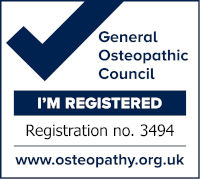What is Osteopathy?
 Osteopathy is a safe and natural approach to healthcare and recovery from injury. It uses no drugs. Instead, osteopaths work with their hands using a highly developed sense of palpation to assess tissue texture, asymmetry, restriction and tenderness of injuries. Osteopaths use a wide range of treatment techniques, such as soft tissue neuromuscular massage, joint mobilisation and articulatory techniques, muscle energy and harmonic techniques, strain-counterstrain, as well as corrective adjustments designed to relieve pain, restore blood flow, drain inflammation and improve the mobility and range of movement of a joint. With their highly trained sense of touch, osteopaths use these manual techniques both to discover underlying causes of pain and to carry out treatment. Its main strength, however, lies in the unique way the patient is assessed from a mechanical, functional and postural standpoint and the way that treatment is planned to suit the needs of the individual patient. Osteopaths spend most of their professional lives dealing with pain. Our role is to alleviate pain, improve mobility and to make patients' lives more comfortable.
Osteopathy is a safe and natural approach to healthcare and recovery from injury. It uses no drugs. Instead, osteopaths work with their hands using a highly developed sense of palpation to assess tissue texture, asymmetry, restriction and tenderness of injuries. Osteopaths use a wide range of treatment techniques, such as soft tissue neuromuscular massage, joint mobilisation and articulatory techniques, muscle energy and harmonic techniques, strain-counterstrain, as well as corrective adjustments designed to relieve pain, restore blood flow, drain inflammation and improve the mobility and range of movement of a joint. With their highly trained sense of touch, osteopaths use these manual techniques both to discover underlying causes of pain and to carry out treatment. Its main strength, however, lies in the unique way the patient is assessed from a mechanical, functional and postural standpoint and the way that treatment is planned to suit the needs of the individual patient. Osteopaths spend most of their professional lives dealing with pain. Our role is to alleviate pain, improve mobility and to make patients' lives more comfortable.
Osteopathy focuses on the musculoskeletal system (the bones, joints, muscles, ligaments and connective tissue) and the way this inter-relates with the functioning of the body as a whole. Osteopaths diagnose and treat "somatic dysfunction", which is impaired or altered function of related components of the somatic system: skeletal, arthrodial and myofascial structures, and their related vascular, lymphatic, and neural elements. Osteopathy is a distinct system of diagnosis and treatment which compliments and supports orthodox medicine. It combines a scientific knowledge of the orthodox medical sciences with specialised methods of evaluation and treatment. It is recognised by The British Medical Association as being a "discrete clinical discipline".
Osteopathy recognises the role of the musculoskeletal system in the healthy functioning of the body. The musculoskeletal system is a key element in maintaining health. This system makes up two-thirds of the body's mass. It impacts and reflects the condition of all other body systems (e.g. respiratory, neurological, cardio-vascular, gastro-intestinal, genitourinary, immune etc).
Video used with permission from ntpages.com.au — Australia’s most visited alternative health site.













